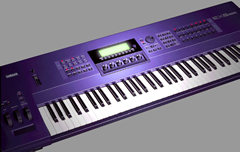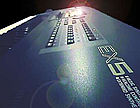| |
| INTRODUCTION |
 |
 |
Introducing
the EX5 synth/workstation, Yamaha combines in the same unit a powerful
synthesis system and sophisticated musical production functions.
Tone generation includes various types of synthesis: AWM, Physical
Modeling,Virtual Acoustic, the new FDSP Yamaha technology and additional
sampling functions. Obviously, it is possible to combine various
kinds of synthesis creating innovative sounds.
On the other hand, it is also possible to create powerful analog
sounds with 70's "style" resonance filters facility.
Very important in the sound creation process is also the flexible
internal effect system. Under the performance point of view, besides
the powerful track and pattern sequencer, for the first time a versatile
4-track arpeggiator and a key-mapping system are available.
The key-mapping function allows to assign sampled loops and pre-programmed
patterns to specific keys of the keyboard. Moreover, a wide range
of realtime controllers and full master keyboard functions are also
available.
 Synthesis
Techniques Synthesis
Techniques
 Technical
Details Technical
Details
|
| MAIN
PLUS |
 |
 |
Synthesis
technologies. The EX5 name comes from EXtended synthesis, meaning
that various and advanced tone generation systems are integrated into
the synthesizer: AWM (Advanced Wave Memory), VA (Virtual Acoustic),
AN (Analog Physical Modeling) e FDSP (Formulated Digital Signal Processing).
The unit is also equipped with an accessory sampling facility (44.1
kHz frequency and 16-bit resolution stereo/mono) featuring 1 Megabyte
DRAM (expandable by optional SIMM and Flash RAM).
Polyphony / multitimbral capability. Featuring a 128 notes polyphony
(126 in AWM plus 1 or 2 notes for VL and AN synthesis), 512 voices
and 128 performance setups, EX5 is ideal for live performances, providing
very powerful and high quality sounds.
It must be also underlined that up to 4 different sounds can assigned
to a voice, each one independently assignable to the keys in Cross-Fade,
Split, Velocity Switch modes 16 parts are available in the Performance
mode (under internal sequencer or external units control), each one
including 1 voice (up to 4 sounds can be combined in 1 voice).
The EX5 keyboard can control a maximum of 2 parts of the selected
Performance. In other words, a maximum of 2 voices (that means up
to 8 different sounds) can be controlled in realtime, combined in
Layer, Split, Velocity Switch and Cross-Fade modes. |
 |
Realtime
control. Pursuing the traditional Yamaha philosophy, the synth
offers a wide range of assignable real time controllers: Pitch bend,
2 Modulation wheels, Ribbon controller, 6 Controller knobs (under
the display), Breath Controller jack and 2 Scene keys, that can be
used to memorize and recall different settings of the Controller knobs,
so that a complete set of knob settings can be instantaneously recalled.
Master keyboard functions. The EX5 is a powerful and versatile
Master Keyboard, that in Performance mode provides an extremely sophisticated
16 channels MIDI control.
Moreover, 2 independent MIDI A and B ouputs are available.
Sequencer. The EX5 is equipped with a 16 tracks Song sequencer
able to store up to 30.000 notes with advanced editing functions.
A 8 tracks Pattern sequencer (max. 50 patterns) is also available
featuring the same editing functions.
The two systems can be combined togheter, allowing memory saving and
creation of relly complex songs.
This typical workstation-oriented facility provides a built-in composer
system always available with just one limit: only 1 song can be loaded
each time.
Data can be stored on the built-in FDD that provides a direct disk
songs playing function for SMF 0 and 1formats.
Arpeggiator. It features the same editing functions available
in the Song and Pattern sequencer and allows the storage of sophisticated
arpeggios sequences on 4 tracks.
Key mapping. Arpeggios, samples or patterns can be assigned
to specific keys of the keyboard, for interesting live performances
applications. |
| |
|
CONCLUSIONS
|
 |
|
|
Without
any doubt, the EX5 main goal is the sound.
At the first approach, it's immediately clear that EX5 is oriented
to sound creation, being able to stimulate the search of new stunning
timbral solutions and the consequent use during "live" performances.
Excellent sound quality and wide range of realtime control functions
are the the most enjoiable features.
The user interface is quite complicated, rather oriented to a technical
approach than to a musical one, despite the availability of many powerful
programming tools.
Besides the various synthesis, EX5 provides an high audio quality
sampling function. Anyway, under the operation point of view, this
facility is limited. For instance, the edit function, despite the
convenient graphic interface, doesn't provide any trim and crossfade
loop function. Moreover, the optional SCSI port seems to have been
really conceived as an accessory instead of a fundamental support
for sample management (data loading time is too slow ).
The sequencer allows a quick storage of musical ideas and features
sophisticated editing functions.The main limit for a "live" use consists
in the fact that just one song can be loaded each time.
On the other hand, arpeggiator and keymap functions are very useful
in "live" situations, being a great support to the performance. |
|
 |



